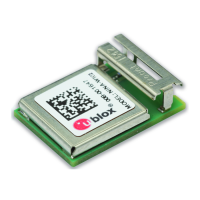
Do you have a question about the Ublox NINA-W1 Series and is the answer not in the manual?
| Power Supply | 3.3 V |
|---|---|
| Operating Temperature | -40°C to +85°C |
| Wireless Standard | IEEE 802.11 b/g/n |
| Frequency Band | 2.4 GHz |
| Max Data Rate | 72.2 Mbps |
| Antenna | Integrated or external antenna options |
| Interface | UART, SPI |
| Security | WPA/WPA2, WEP |
| Connectivity | Wi-Fi and Bluetooth |
Provides a general introduction to the NINA-W1 series of wireless and multiradio MCU IoT modules.
Details the dual-core Xtensa LX6 CPU architecture and internal memory specifications of NINA-W1 modules.
Explains the power-efficient operating modes and configurations available for NINA-W1 series modules.
Describes the VCC and VCC_IO supply interfaces, including design considerations and application circuits.
Covers essential system interfaces such as boot strapping pins and debug printout control.
Details the supported data interfaces, including UART and Ethernet (RMII+SMI).
Discusses the integrated PCB trace antenna design for simplified integration and optimal RF performance.
Advises against connecting reserved pins, allocated for future interfaces and functionality.
Emphasizes the importance of good electrical connection of GND pins for RF performance and EMC.
Describes the embedded u-connectXpress software for NINA-W13/W15, managing Bluetooth and Wi-Fi connectivity via AT commands.
Introduces the ESP-IDF Software Development Kit for developing applications on NINA-W10 open-CPU modules.
Guides on using the ublox s-center client software to upgrade firmware on NINA-W13 and NINA-W15 modules.
Explains the process of updating the u-connectXpress software using the s-center client for NINA-W13/W15 modules.
Details the steps for setting up the ESP-IDF environment and developing/flashing software for NINA-W10 open-CPU modules.
Explains how to use the Arduino platform with NINA-W10 for accessing third-party hardware like displays and sensors.
Provides an overview of design guidelines for optimal integration of NINA-W1 series modules into application boards.
Details the VCC, VCC_IO, and GND pin connection guidelines for NINA-W1 series modules.
Offers guidelines for antenna placement and enclosure considerations for NINA-W1x6 modules.
Focuses on layout design for UART and Ethernet interfaces to avoid noise and ensure signal integrity.
Presents best practices for routing high-speed signals and buses on PCBs for NINA-W1 series modules.
Recommends Non Solder Mask Defined (NSMD) pad type and paste mask layout for NINA-W1 series modules.
Provides thermal testing information and grounding recommendations for NINA-W1 series modules.
Covers Electro-Static Discharge (ESD) immunity requirements and protection measures for NINA-W1 modules.
Refers to data sheets for information on packaging, shipping, storage, and moisture sensitivity of NINA-W1 modules.
Details essential precautions for handling ESD-sensitive NINA-W1 modules, including antenna handling.
Provides guidelines for reflow soldering processes, cleaning, and other soldering-related remarks for NINA-W1 modules.
Covers compliance with the Radio Equipment Directive (RED) and RoHS directive for NINA-W1 series modules.
Details FCC modular approval, labeling requirements, RF exposure, and end-product compliance for NINA-W1 modules.
Outlines Canadian ISED certification, labeling, and RF exposure compliance for NINA-W1 modules.
Specifies requirements for Japanese market placement, including the Giteki marking.
Describes the automatic testing procedures used by u-blox for quality control of NINA-W1 modules.
Focuses on OEM responsibilities for module assembly, component assembly, and RF performance testing of the end product.
Provides definitions for abbreviations and terms used throughout the NINA-W1 series user manual.
